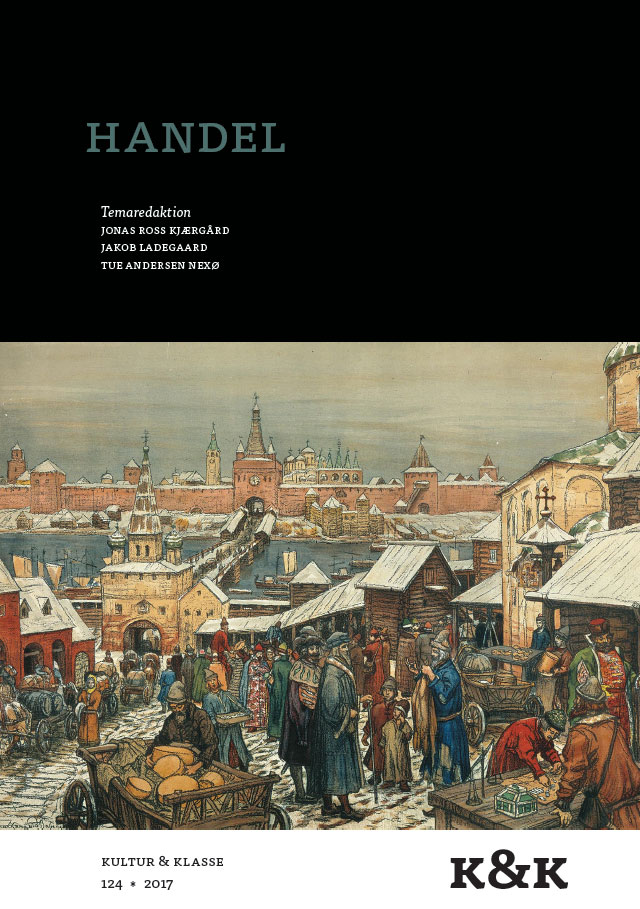Børnepenge: Om handel som netværksskabende aktivitet, særlige pengesedler og børn som forbrugere i Forschungstheaters Børnebanken
DOI:
https://doi.org/10.7146/kok.v45i124.103932Nøgleord:
Forschungstheater, Relationel æstetik, Penge, Børn som forbrugere, Normkritisk tilgang til samfundsstrukturerResumé
This contribution analyzes the interactive art project Die Kinderbank as it was displayed by the German Forschungstheater at Horsens Art Museum under the Danish title Børnebanken in February 2017. Børnebanken is analyzed as aesthetical art work as well as norm-critical experiment. The first, because the concept and scenography of Børnebanken can be seen as illustrative for idealistic conceptions of children, money, and trade. And the second, because Børnebanken with its interactive format is a potentially ‘uncontrollable’ work, which might lead to interesting clashes between the ideological point of departure and the practical reality. Clashes, which can be used to discuss, how we – in a relatively wealthy Western context – see ourselves as participants in a society of trading and comsuming, and not least how we imagine the role of our children in this society.
My analysis addresses, how Forschungstheater in their set-up points towards a Marxist-socialist critique of capitalism as illustrated by Bertolt Brecht as well as a more complex concept of money as a concrete, society-constituting and -consolidating symbol as described by Viviana A. Zelizer. It also discusses how Børnebanken as an example of Nicolas Bourriaud’s concept of Relational Aesthetics is a work beyond our control. On that note, I ask the question of to what extend the discussions of money as societal phenomenon reach the primary target group: the children. My point is that the reactions of the children on the set-up of Børnebanken might point toward a critical consumer-behaviour rather than a norm-less curiousity.
Referencer
Banco Palmas’ projektbeskrivelse. 29. juni 2017: https://www.changemakers.com/bankingonsocialchange/entries/palmas-bank.
Brecht, Bertolt. Die Dreigroschenoper/von Bertolt Brecht nach John Gay’s ’The Beggar’s Opera’. Berlin: Edition Suhrkamp, 1968.
Bishop, Claire. “Antagonism and Relational Aesthetics”. OCTOBER 110 (2004): 51-79.
Bourriaud, Nicolas. Relationel æstetik. København: Det Kongelige Danske Kunstakademi, 2005.
Fischer-Lichte, Erika. The Transformative Power of Performance. A new aesthetics. London & New York: Routledge, 2008 .
Fischer-Lichte, Erika. ”Culture as Performance”. Modern Austrian Literature 42: 3 (2009): 1-10.
Hinton, Stephen. Kurt Weill: The Threepenny Opera. Cambridge: Cambridge University Press, 1990.
Holm Sørensen, Birgitte og Ingelise Flensborg. Temaer i billedpædagogik. København: Gad, 1997.
Imagination for people. Banco Palmas. Local currencies in Brazil’s favelas. http://imaginationforpeople.org/en/project/banco-palmas/
Jalving, Camilla. ”Kunst på grænsen”. Kristeligt Dagblad 19. juni 2002 https://www.kristeligt-dagblad.dk/kultur/kunst-p%C3%A5-gr%C3%A6nsen
Kowalski, Hannah. Manuskript til Børnebanken: Introduktion og to skuespil: Der Bulle, die Maus und der Frosch og Der Bulle und die Kröte. Videregivet pr. mail af Hannah Kowalski, 29. marts 2017.
Kowalski, Hannah. Manuskript til mundtlig opsamling på Børnebanken på Horsens Kunstmuseum, lørdag d. 18. februar 2017.
Peters, Sibylle. ”Participatory Children’s Theatre and the Art of Research: The Theatre of Research/Das Forschungstheater 2003-2013”. Youth Theatre Journal 27 (2013): 100-112. http://dx.doi.org/10.1080/08929092.2013.837693
Read, Herbert. Kunstens Græsrødder. København: Wivels Forlag, 1949.
Ring Pedersen, Anne. “De usynlige etniske grænser”. Information 25. juli 2003 https://www.information.dk/debat/2003/07/usynlige-etniske-graenser
Zelizer, Viviana A. ”The Social Meaning of Money: ’Special Monies’”. American Journal of Sociology 95 2 (1989): 342-377.
Die Kinderbank, 29. juni 2017: http://www.kinderbank-hamburg.de/Kinderbank/Home.html
Downloads
Publiceret
Citation/Eksport
Nummer
Sektion
Licens
Tidsskriftet følger dansk ophavsret.





